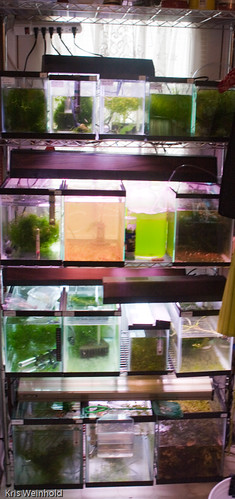GWAPA: February Meeting: Lighting
March 1st, 2009GWAPA’s February meeting was at Rick and Mary’s house in northern Virgina. Rick gave an excellent presentation about the various lighting options available for planted aquariums. He showed some charts which compared the various types of lighting (T12, T5, MH, PC, etc) and how efficient they are in terms of lumens per watt. From this, he described how the watts/gallon rule breaks down on deeper aquariums. Another member, Jim, discussed how he actually calculated the light produced in terms of lumens per square inch, which is a much better rule of thumb when comparing different light sources. Finally, Sean showed off a LED light strip that he uses, and discussed the benefits, downsides, and future of LED lighting in the aquarium hobby. Right now, it’s largely cost prohibitive to light your tank exclusively using LED lighting due to the cost of producing LEDs that can equally produce white light and light that can be used in photosynthesis. That said, when he’s replaced roughly 70 watts of PC light with a 17 watt LED strip, I’m looking forward to seeing LED technology become more prominent in the hobby.
Rick has a nice 75G aquarium, which features a huge stand of Bacopa monnieri growing emersed, and even flowering up and out of his aquarium. After the auction, Rick demonstrated his automatic water change system, which is why the water levels in this picture are a little bit low.
Mary maintains a nice ADA aquarium setup, but unfortunately had a lush foreground of Utricularia graminfolia melt about a week before the meeting. She said that it had completely covered the foreground, and was looking great for months, but then a brown patch formed, and 2 days later, nearly all of it had melted away. I’ve experienced Utricularia taking awhile to get established, but haven’t had it melt away this dramitically. Has anyone else experienced this misfortune?
Rick and Mary also maintain an impressive rack of smaller aquariums, which they use to raise guppies, shrimp, bettas, and live food such as daphnia cultures. All in all, it was another great club meeting with almost 100 items in our auction, and a great gathering of aquarists.



March 1st, 2009 at 6:10 pm
Do you have more information on the LED system he is using? Is a purchased setup or a home built one?
March 1st, 2009 at 7:24 pm
m@, I believe it’s the Aquabar. The main thing to note with this fixture, is that it emits no white light, so by itself, the tank/plants look brown, but the plants are photosynthesizing because the LEDs are fixed to very specific colors of light just for plants. For human viewing, you’ll want to supplement with a white light source.
March 1st, 2009 at 10:08 pm
I am so looking forward to LEDs becoming more available and cheaper. I picked up a small LED moonlight that I thought might be strong enough to light a nano of mine but it didn’t work quite the way I wanted it to. (Ended up trading it for a really nice group of keyhole cichlids so I guess it turned out all right. :D)
March 2nd, 2009 at 2:46 am
I’ve seen this. So these aren’t standard LEDs. I can’t wait for these things to come down in price. The energy savings is nice, but when the starting sticker price is so high it doesn’t amount to much.
March 2nd, 2009 at 9:15 am
Well, actually, the price isn’t too bad considering there are no bulb replacements. If you follow most advice and replace bulbs every 1 year (PC) or 18 months (T5), and figure each bulb is $15-$20 on average, the cost of operating conventional fixtures isn’t too cheap either. That’s not even counting the higher electricity costs. I believe most of the LED strips are rated to last at least 10 years without any bulb replacement, so it probably evens out eventually.
March 24th, 2009 at 1:30 pm
Was Mary dosing Seachem Excel (or oversdosing to get the tank ready to show off)? I know Excel can damage Riccia and Monosolenium Tenerum which are both liverworts as you described – a patch turns brown and then spreads to the remainder of the bunch. If I’m not mistaken, Hutricularia graminfolia is a Bladderwort. Could it be affected the same way?
March 24th, 2009 at 7:12 pm
Very possible, mstevenson. Utricularia is definitely a bladderwort, so you might be on to something. Thanks for commenting!